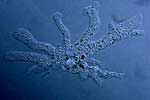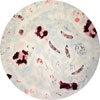 | |||
| |||
| Sizing up genomes: Amoeba is king | |||||||||||||||||||||||||||||||||||||||||||||
| Reasons for the size of a genome and the number of genes are not clear | |||||||||||||||||||||||||||||||||||||||||||||
| By Edward R. Winstead February 12, 2001 |
Biologists have been estimating the size of genomes for decades. In 1971, for example, researchers reported that a species of Italian bat, Miniopterus, has a genome half the size of the human genome. Similarly, the genome of Muntiacus, a species of Asian barking deer, was estimated at about 70 percent of that of humans. As reported this week, the human genome contains about 3 billion chemical units of DNA, or base pairs. In the animal kingdom, the relationship between genome size and evolutionary status is not clear. One of the largest genomes belongs to a very small creature, Amoeba dubia. This protozoan genome has 670 billion units of DNA, or base pairs. The genome of a cousin, Amoeba proteus, has a mere 290 billion base pairs, making it 100 times larger than the human genome. A Sample of Species and Genome Size (in base pairs)
Among the organisms whose genomes are sequenced, genome size does not correlate with the number of genes.
. . . | ||||||||||||||||||||||||||||||||||||||||||||













